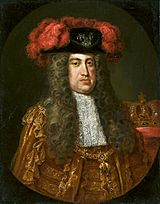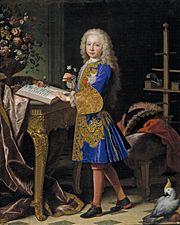Treaty of Vienna (1731) facts for kids
| Treaty of Peace and Alliance | |
|---|---|
 |
|
| Context | Britain and the Dutch Republic accept the Pragmatic Sanction; Austria withdraws from Parma & Piacenza and accepts Charles of Spain as duke; Closure of Ostend Company |
| Signed | 16 March 1731 |
| Location | Vienna |
| Negotiators |
|
| Parties | |
The 1731 Treaty of Vienna was an important agreement signed on March 16, 1731. It was made between Great Britain, Emperor Charles VI (who ruled the Habsburg monarchy), and the Dutch Republic.
This treaty ended the old alliance between Britain and France, which had been strong since 1713. Instead, Britain and Austria became allies. Later, Spain also signed the treaty on July 22, 1731. After Spain joined, Austria agreed that Charles of Spain would become the Duke of Parma and Piacenza, two important areas in Italy.
Why the Treaty Was Needed

After the Peace of Utrecht in 1713, European countries often changed their alliances. They tried to solve problems without going to war. France, for example, needed peace to rebuild its economy after a big war. This led to the alliance between Britain and France in 1716.
Even though Britain and France were a bit suspicious of each other, this alliance was important. When George I became king of Britain in 1714, he was also concerned about his lands in Hanover. This made the alliance even more useful for Britain.
The Treaty of Utrecht had made Philip V the first Bourbon king of Spain. However, Britain kept control of the Spanish ports of Gibraltar and Mahón, Menorca. Spain wanted these ports back. Spain had also given up its lands in Italy, like Naples, Sicily, Milan, and Sardinia. These Italian lands became very important for Spain's foreign policy. This was largely because of Elisabeth Farnese, Philip V's second wife. She wanted to create a kingdom in Italy for her own children.
There were also trade issues. The Austrian-owned Ostend Company was competing with British, French, and Dutch merchants for trade in the East Indies. Spain was also worried about British ships in New Spain.
By the 1730s, Emperor Charles VI of Austria needed support for his 1713 Pragmatic Sanction. This was a rule he made to ensure his daughter, Maria Theresa, could inherit his lands. All these issues led to many meetings and agreements between European powers. One of these was the Peace of Vienna in 1725 between Austria and Spain. However, this alliance did not last long. Charles VI soon decided that an alliance with Britain and the Dutch Republic would be better for Austria.
Key Agreements of the Treaty

In an earlier agreement, the 1720 Treaty of The Hague, Britain, France, the Dutch Republic, and Austria had agreed that Charles of Spain, the third son of Philip V, would become the Duke of Parma and Tuscany.
Even though Britain and France confirmed this in the Treaty of Seville in 1729, Austria did not agree. When Antonio Farnese, the Duke of Parma, died in January 1731, Austria took control of the Duchy. The 1731 Treaty of Vienna made Austria withdraw its troops. Charles of Spain was then officially made the Duke.
The treaty also closed the Austrian-backed Ostend East India Company. This company was started in 1722 and had become a big rival to the British and Dutch East India companies. Emperor Charles VI had already tried to close the company in 1727 to get support for his Pragmatic Sanction. However, Britain made sure its permanent closure was a condition for signing the 1731 Treaty.
What Happened Next
From 1733 to 1735, during the War of the Polish Succession, Charles of Spain took control of the Kingdom of Naples, which used to belong to Spain. Because of this, the 1738 Treaty of Vienna returned Parma and Piacenza to Emperor Charles VI.
However, Charles VI died in 1740, which led to the War of the Austrian Succession. The 1748 Treaty of Aix-la-Chapelle then gave Parma to Charles of Spain's younger brother, Philip. Charles himself became king of Spain in 1759, after his older brother Ferdinand VI died.
The alliance between Britain and Austria lasted until 1756. That year, a big change called the Diplomatic Revolution happened. This led to new alliances, with long-time rivals France and Austria becoming allies.
See also
 In Spanish: Tratado de Viena (1731) para niños
In Spanish: Tratado de Viena (1731) para niños

